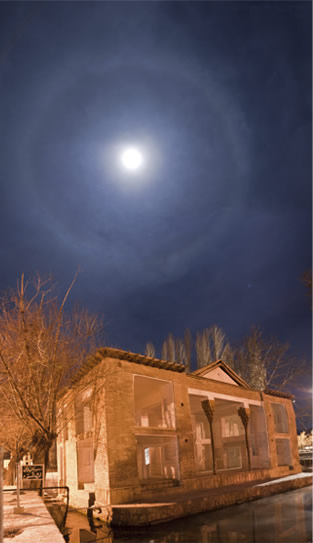Cheshmeh-Ali Halo
Cheshmeh-Ali Halo: A Mesmerizing Atmospheric Phenomenon
The Cheshmeh-Ali Halo is a captivating atmospheric optics phenomenon that adds a touch of enchantment to the night sky. This remarkable halo, with its 22° radius, is formed by the interaction of light with ice crystals suspended in the air. While the exact characteristics and behavior of these crystals remain somewhat mysterious, they are believed to be hexagonal in shape, with prism side faces inclined at a 60° angle to each other.
Unlike the more commonly observed sundogs, which are also halos caused by ice crystals, the Cheshmeh-Ali Halo appears as a circular ring of light surrounding the moon. The crystals responsible for this mesmerizing spectacle are arranged in a somewhat random manner, resulting in the formation of the circular halo.
Located approximately 220 miles north of Tehran, Iran, the Cheshmeh-Ali Palace provides a picturesque backdrop for this celestial phenomenon. Dating back to the Safavid Dynasty (1501 to 1722), this historic palace was primarily used by the Safavid kings and courtiers for recreational purposes. Nestled amidst shallow waters originating from the Cheshmeh Ali hot water spring, the palace's surroundings offer a serene setting for observing the awe-inspiring Cheshmeh-Ali Halo.
Despite its frequent occurrence, the Cheshmeh-Ali Halo continues to captivate and intrigue both scientists and sky enthusiasts alike. While we may not fully understand the precise nature of the ice crystals responsible for its formation, their hexagonal shape and inclination of prism side faces play a significant role in creating this ethereal display.
To delve deeper into the science behind this phenomenon, it's important to note that the Cheshmeh-Ali Halo is categorized as a type of ice halo. Ice halos occur when light interacts with ice crystals suspended in the atmosphere, causing the light to refract and create stunning optical effects. These halos can take various forms, including the familiar 22° halo, sundogs, and circumzenithal arcs, among others.
While the Cheshmeh-Ali Halo may seem elusive and rare, it is actually more common than one might think. Ice halos, including this particular halo, can occur in regions with colder climates and when specific atmospheric conditions are met. The presence of ice crystals in the air, combined with the angle at which light passes through them, determines whether a halo will form and what its characteristics will be.
It is worth noting that ice halos are not limited to lunar halos alone. They can also occur around the sun, creating dazzling displays during the day. These halos, known as solar halos, share similarities with their lunar counterparts but have their own unique characteristics and patterns.
As we continue to explore the fascinating world of atmospheric optics, phenomena like the Cheshmeh-Ali Halo remind us of the wonders that surround us. The interplay between light and ice crystals in the atmosphere produces breathtaking displays that leave us in awe of nature's beauty. Whether observed in the tranquil surroundings of the Cheshmeh-Ali Palace or elsewhere in the world, this celestial phenomenon serves as a reminder of the intricate and captivating nature of our atmosphere.

Lunar Halo, Cheshmeh-Ali, Iran ~ Imaged on 30th January, the night of the year's largest full moon by Mahdi Zamani (site). ©Mahdi Zamani, shown with permission.
The precise nature and habits of the crystals producing the 22° radius ice halo are not known with certainty. Perhaps surprising as it is, with sundogs the most commonly occurring of the halos. But their form is hexagonal and the halo comes from rays passing between prism side faces inclined 60° to each other. Whatever their form, the crystals are more or less randomly aligned to form the circular halo.
"Located some 220 miles north of Tehran, the palace in the photo dates back to the Safavid Dynasty (1501 to 1722). The palace which is surrounded by shallow water coming from the Cheshmeh Ali hot water spring was mainly used by the Safavid kings and courtiers for recreation."
Note: this article has been automatically converted from the old site and may not appear as intended. You can find the original article here.
Reference Atmospheric Optics
If you use any of the definitions, information, or data presented on Atmospheric Optics, please copy the link or reference below to properly credit us as the reference source. Thank you!
-
<a href="https://atoptics.co.uk/blog/cheshmeh-ali-halo/">Cheshmeh-Ali Halo</a>
-
"Cheshmeh-Ali Halo". Atmospheric Optics. Accessed on April 18, 2024. https://atoptics.co.uk/blog/cheshmeh-ali-halo/.
-
"Cheshmeh-Ali Halo". Atmospheric Optics, https://atoptics.co.uk/blog/cheshmeh-ali-halo/. Accessed 18 April, 2024
-
Cheshmeh-Ali Halo. Atmospheric Optics. Retrieved from https://atoptics.co.uk/blog/cheshmeh-ali-halo/.